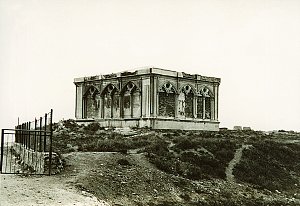The collector Moïse de Camondo, born in Istanbul in 1860, descended from a family of Sephardic Jews. In the early nineteenth century, the Camondos founded a bank that became one of the largest in the Ottoman Empire. In 1867, they were ennobled by Victor Emmanuel II in recognition of their financial support of the unification of Italy.
The Camondo brothers Abraham-Behor and Nissim settled in Paris at the end of the Second Empire, in two mansions on rue de Monceau.
The two cousins of the next generation, Abraham-Behor’s son Isaac and Nissim’s son Moïse, became figures of the art world and shrewd collectors. With his eclectic tastes, Isaac (1851-1911) compiled an impressive collection of eighteenth-century artworks, Japanese prints, Far Eastern art objects and Impressionist paintings, which he bequeathed to the Musée du Louvre in 1911.

The Camondo family mausoleum in Haskoy
© MAD, Paris
Moïse followed Isaac’s example, but was only interested in the French eighteenth century. Wanting a home that suited his tastes and in which he could present his collection, he had his father’s mansion demolished in 1911 and asked the architect René Sergent to replace it with a house of classical appearance and modern comfort.
The mansion that was designed to house his collection was also home to his two children, Nissim (1892-1917) and Béatrice (1894-1945), who lived with him after the departure of his wife, Irène Cahen d’Anvers, and their divorce in 1902.